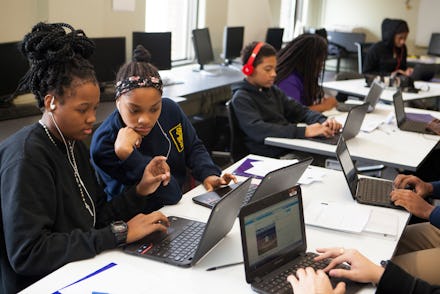Blended Learning Is Making Teachers More Productive in the Classroom. Here's How.

Across the country, teachers are weaving technology into their lesson plans and classrooms, even if they aren't teaching intro to typing or programming.
Blended learning is an educational approach in which students learn in some part through instruction or content from digital or online media — and it's on the rise. More teachers are adopting blended learning methods to bring technology into every subject area. These tools are making teachers more productive by giving them even more options for engaging lesson plans and more time to focus on individual students when not instructing the class at once.
While most public schools do not have a computer for every student in every class, computer labs and roving laptop carts help teachers to fill the gap when they need to use technology in class.
"I use technology all of the time to have students find a different way of gathering information," Virginia social studies teacher Jill Found told Mic. "It's really important that my students know how to gather information using technology because that's the most powerful thing they can do with it."
Blending IRL and online: In 2010, more than 4 million elementary through high school students participated in some kind of learning online, according to a report from the Clayton Christensen Institute. This number is only growing.
Online education marketplaces like Teachers Pay Teachers are also making it easier for teachers to find tech-focused lesson plans and tools to use with their students — and they're making money off it along the way. Teachers can upload their own lessons to the site and sell them for as little as $1 to fellow teachers, who can log on and download for classroom use.
"If they are using technology and computers, they are using them because those are really powerful tools that allow students to create and construct powerful ideas."
While the success of blended learning programs is debatable, incorporating technology more actively into any subject helps students learn basic tech skills they will need later in life. And it engages them with material in a completely new, potentially more effective, way.
Tracy Rudzitis teaches technology and digital media classes at the Computer School, a public middle school in New York City's Upper West Side neighborhood. She teaches computer programming and other courses in which students design and build real-world projects using PCs.
"If they are using technology and computers, they are using them because those are really powerful tools that allow students to create and construct powerful ideas," Rudzitis told Mic. "They can use a computer to create a program, which is much more powerful than drawing a picture."
Teaching desktop skills for the mobile generation: Kids in schools now are the first digitally native generation, growing up with the Internet and smartphones as the status quo. But that often doesn't translate into really understanding how to use a computer. They might be on their phones every second but unable to perform what seems like the simple task of starting a paper in a Microsoft Word document.
"Teaching students how to use computers is such a vital and important skill," Found said. "Even if your students know how to download an app, it doesn't mean they know how to save something to a flash drive, and those are really basic skills they are going to need for college or the working world."
Found teaches world history and geographic information systems to high school students at Liberty High School in Fauquier County, Virginia. In her world history class, she tries to incorporate technology in some way a couple of times a week. She plays review games with her students through apps they can use on their phones, and she uses PC laptop carts for bigger projects like creating interactive posters and maps to better understand historical concepts.
When Found plays an interactive review game through an app, or when she has a classroom full of students hovered over PC laptops making something from scratch, she is engaging with her students even though she's only guiding them to use these technologies. This helps her reach more students directly at the same time, even if she is directing their learning through technology.
At Found's school, students are required to take at least one online-based course before they graduate. Over the last few years alone, technological advances have changed the way universities and schools provide classes to accommodate people's increasingly mobile lives. As online courses and massive open online courses, or MOOCs, increasingly become the way universities offer classes and people learn new skills in the working world, the requirement is meant to prepare students for that type of learning.
"They are really understanding how computers work or how technology works and how they can have some kind of control over that," Rudzitis said. "Classes will often be like, 'It's time for art, now it's time for math, now it's time for history.' They are not often thinking that life is about everything. This is more real life where everything is blended together. Everything has some creativity, some artistic expression, some math, some engineering, some science."